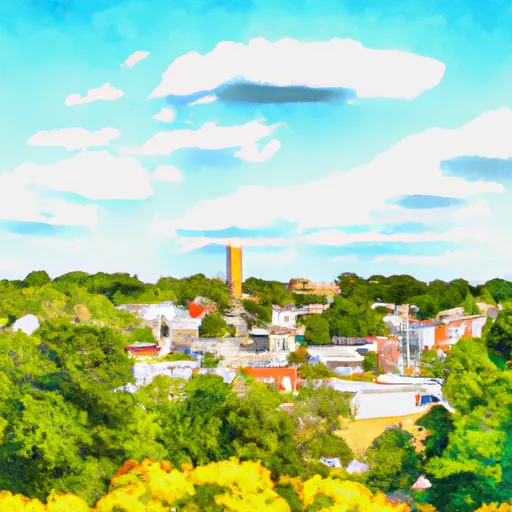-
 Snoflo Premium
Snoflo Premium
Get unlimited access to all our content
With no Ad interruptions! - Start Your Free Trial Login with existing account
Woodsboro
Eden Index
Climate
8.3
•
Recreation
7.2
•
Community
3.1
•
Safeguard
6.6/10

Woodsboro, Maryland is a charming town located in Frederick County. Situated in the Mid-Atlantic region of the United States, Woodsboro experiences a humid subtropical climate. Summers tend to be hot and humid with average temperatures ranging from the mid-70s°F to the low 90s°F, while winters are generally cold with temperatures dropping to the mid-20s°F. The area receives moderate rainfall throughout the year, with occasional snowfall during the winter months.
Woodsboro is surrounded by beautiful natural landscapes, offering various outdoor recreation opportunities for residents and visitors. The town lies close to several water bodies, including the Monocacy River and Hunting Creek, providing opportunities for fishing, kayaking, and canoeing. Nature enthusiasts can explore the nearby Catoctin Mountain Park, where they can enjoy hiking, camping, and picnicking amidst stunning scenery.
Additionally, Woodsboro is home to several parks and green spaces, offering options for walking, jogging, and enjoying outdoor activities. Popular parks in the area include Woodsboro Park and Glade Valley Community Park, providing sports fields, playgrounds, and picnic areas.
Overall, Woodsboro, Maryland offers a pleasant climate, access to water bodies, and a variety of outdoor recreational opportunities for individuals to enjoy nature and stay active.
What is the Eden Index?
The Snoflo Eden Index serves as a comprehensive rating system for regions, evaluating their desirability through a holistic assessment of climate health, outdoor recreation opportunities, and natural disaster risk, acknowledging the profound impact of these factors on livability and well-being.
Climate Health Indicator (CHI): 8.3
Woodsboro receives approximately
1097mm of rain per year,
with humidity levels near 86%
and air temperatures averaging around
12°C.
Woodsboro has a plant hardyness factor of
6, meaning
plants and agriculture in this region thrive during a short period during spring and early summer. Most
plants will die off during the colder winter months.
By considering the ideal temperature range, reliable water supplies, clean air, and stable seasonal rain or snowpacks, the Climate Health Indicator (CHI) underscores the significance of a healthy climate as the foundation for quality living.
A healthy climate is paramount for ensuring a high quality of life and livability in a region, fostering both physical well-being and environmental harmony. This can be characterized by ideal temperatures, reliable access to water supplies, clean air, and consistent seasonal rain or snowpacks.
Weather Forecast
Streamflow Conditions
Potomac
Area Rivers
Potomac
Snowpack Depths
Potomac
Reservoir Storage Capacity
Potomac
Groundwater Levels
Recreational Opportunity Index (ROI): 7.2
The Recreational Opportunity Index (ROI) recognizes the value of outdoor recreational options, such as parks, hiking trails, camping sites, and fishing spots, while acknowledging that climate plays a pivotal role in ensuring the comfort and consistency of these experiences.
Access to outdoor recreational opportunities, encompassing activities such as parks, hiking, camping, and fishing, is crucial for overall well-being, and the climate plays a pivotal role in enabling and enhancing these experiences, ensuring that individuals can engage in nature-based activities comfortably and consistently.
Camping Areas
| Campground | Campsites | Reservations | Toilets | Showers | Elevation |
|---|---|---|---|---|---|
| Prince William Forest RV Campground | 24 | 270 ft | |||
| Burke Lake Park | None | 327 ft | |||
| Smallwood State Park | 15 | 16 ft | |||
| Lake Fairfax | None | 321 ft | |||
| Little Bennett Regional Park | 90 | 644 ft | |||
| Pohick Bay Regional Park | 150 | 126 ft | |||
| Bull Run Regional Park | None | 156 ft | |||
| Fort Belvoir Travel and RV Camp | 52 | 132 ft | |||
| Oak Ridge - Prince William Forest Park | None | 364 ft | |||
| Gambrill State Park | 34 | 1,186 ft |
Nearby Ski Areas
Catastrophe Safeguard Index (CSI):
The Catastrophe Safeguard Index (CSI) recognizes that natural disaster risk, encompassing floods, fires, hurricanes, and tornadoes, can drastically affect safety and the overall appeal of an area.
The level of natural disaster risk in a region significantly affects safety and the overall livability, with climate change amplifying these risks by potentially increasing the frequency and intensity of events like floods, fires, hurricanes, and tornadoes, thereby posing substantial challenges to community resilience and well-being.
Community Resilience Indicator (CRI): 3.1
The Community Resilience Indicator (CRI) recognizes that education, healthcare, and socioeconomics are crucial to the well-being of a region. The CRI acknowledges the profound impact of these elements on residents' overall quality of life. By evaluating educational resources, healthcare accessibility, and economic inclusivity, the index captures the essential aspects that contribute to a thriving community, fostering resident satisfaction, equity, and social cohesion.

